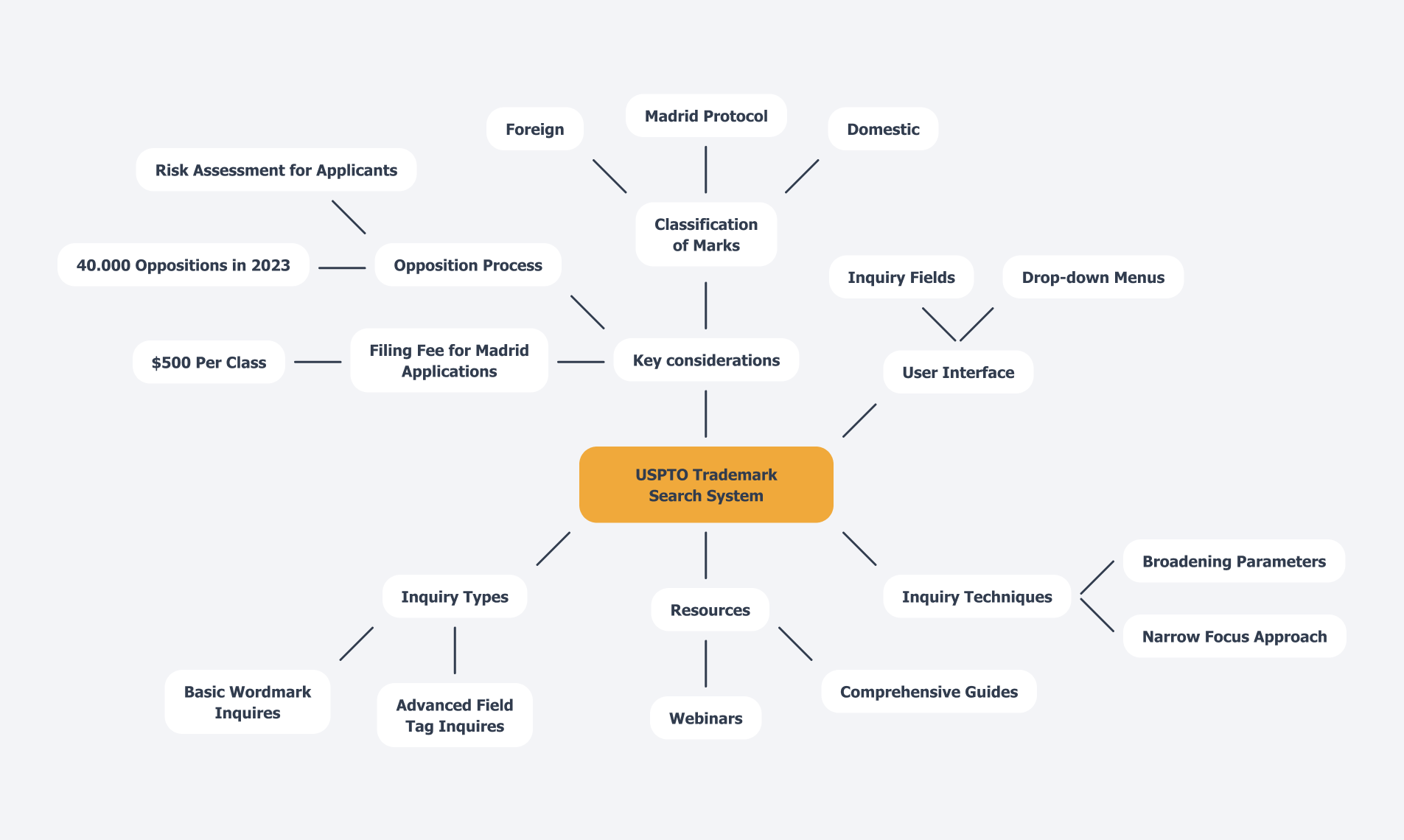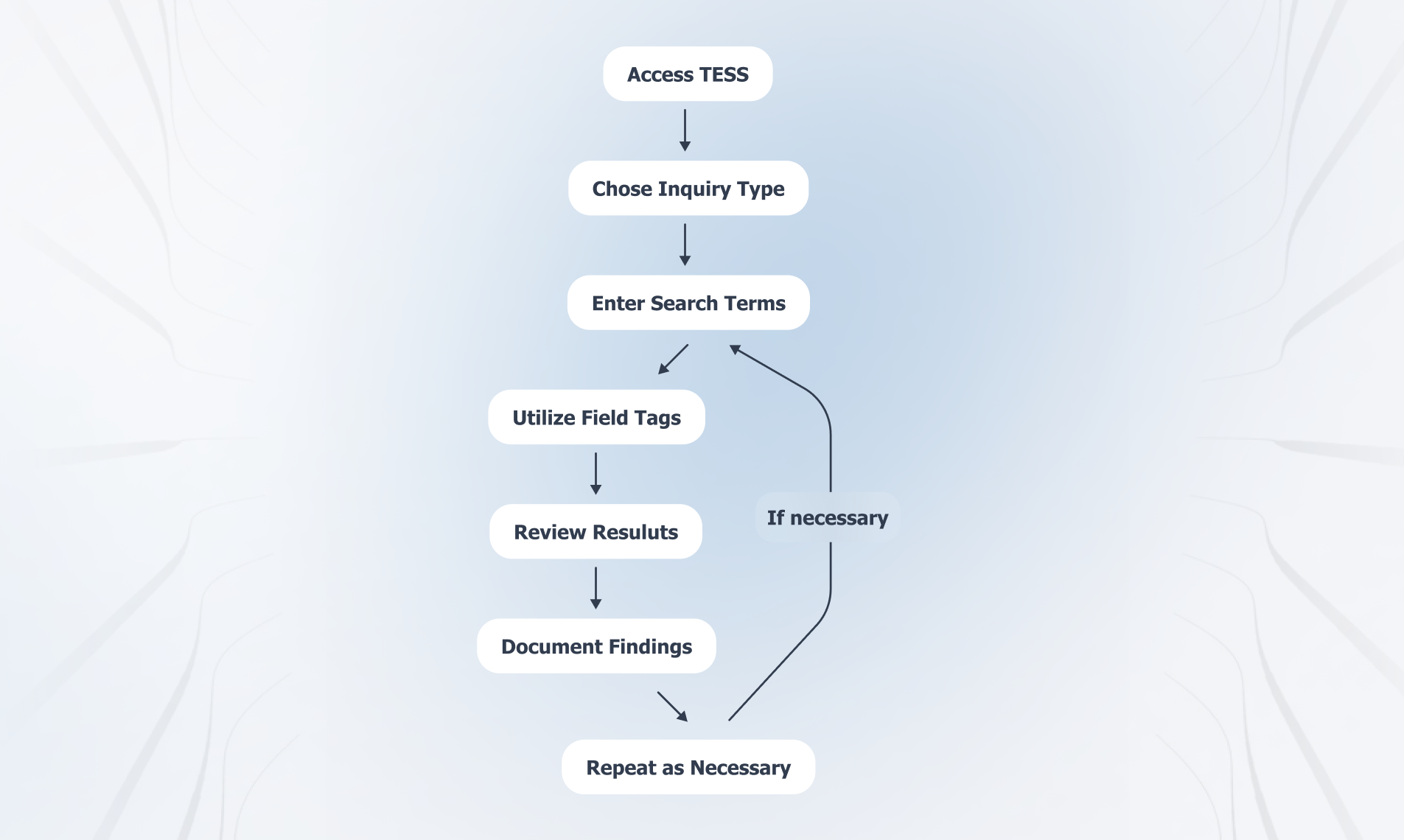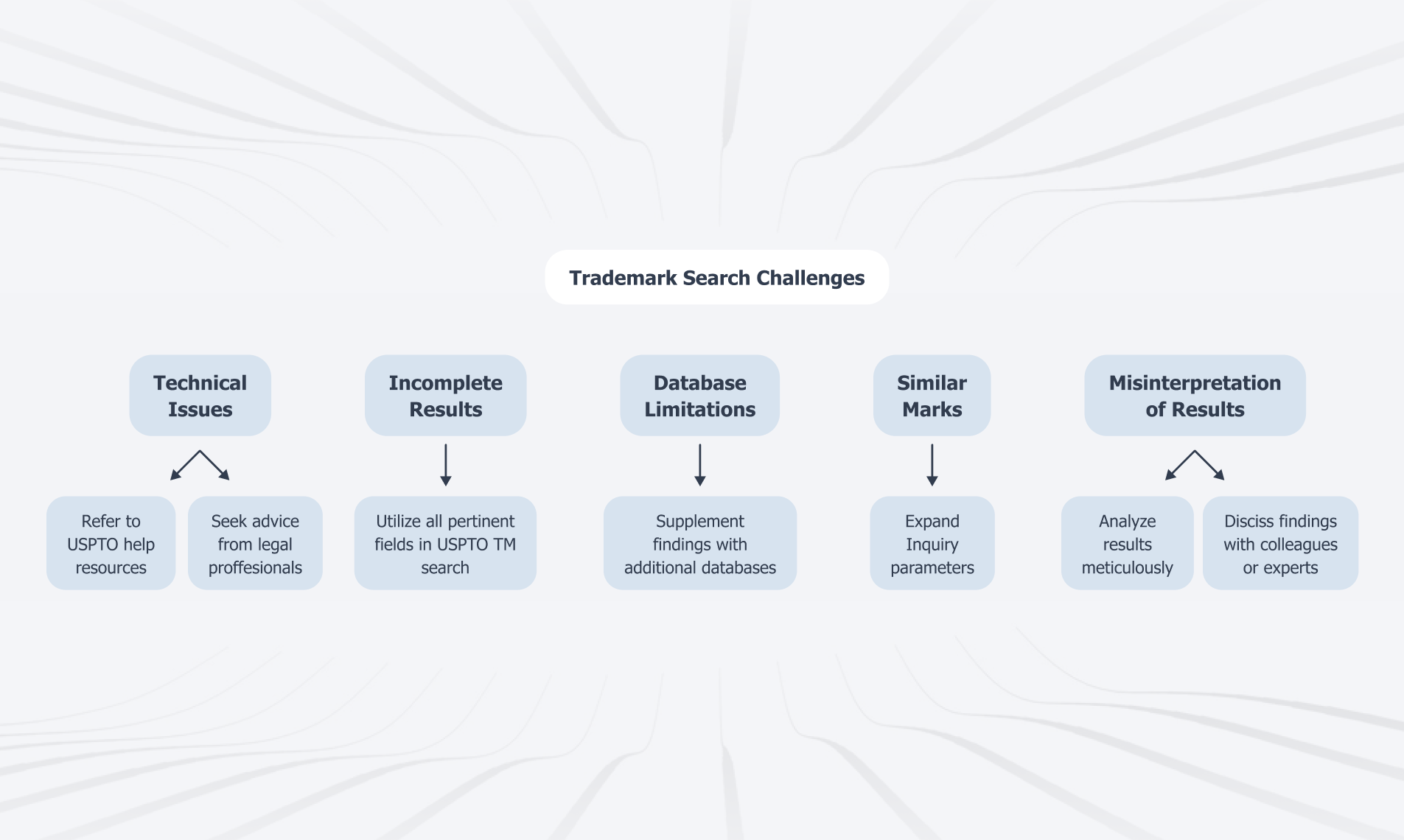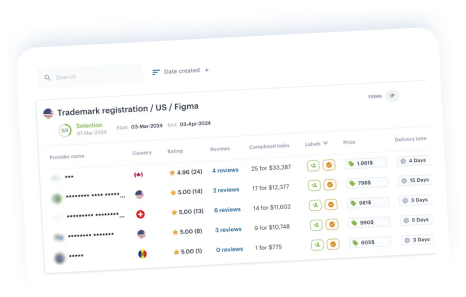Overview
This article serves as a comprehensive guide for corporate IP managers, detailing the effective execution of a USPTO trademark search through the Trademark Electronic Search System (TESS). It underscores the critical importance of grasping various inquiry types, employing strategic search techniques, and leveraging available resources to adeptly navigate the complexities of trademark registration. By doing so, it significantly reduces the risk of conflicts with existing marks, ensuring a smoother registration process.
Introduction
Navigating the intricate landscape of trademark registration presents a significant challenge, particularly for those who may be unfamiliar with the nuances of this critical process. With an ever-increasing number of trademarks filed each year, it becomes imperative to understand how to effectively search for existing marks to avoid potential conflicts. This article explores the essential components of the USPTO Trademark Search
System, providing step-by-step guidance on conducting thorough searches while addressing common challenges that may arise. By leveraging the appropriate tools and resources, applicants can refine their search strategies, ensuring their trademarks are not only unique but also defensible in a competitive marketplace.
Understand the USPTO Trademark Search System
The uspto tm search, primarily accessed through the Trademark Electronic Search System (TESS), serves as an essential resource for identifying existing trademarks that may conflict with proposed marks. Understanding its key components is critical for effective navigation and execution of queries in the uspto tm search.
- Inquiry Types: Familiarize yourself with various inquiry types, such as basic wordmark inquiries and advanced field tag inquiries, to tailor your approach according to specific requirements.
- User Interface: Master the layout of the USPTO website, including drop-down menus and inquiry fields, to navigate with ease and enhance your exploration efficiency.
- Inquiry Techniques: Employ effective inquiry techniques by starting with a narrow focus and gradually broadening your parameters. This strategy significantly increases the chances of uncovering potential conflicts.
- Resources: Leverage the USPTO’s comprehensive guides and webinars to deepen your understanding of the system and refine your inquiry skills.
As of 2025, the USPTO database boasts a substantial number of marks, highlighting the ongoing necessity for mark registration. The efficiency of TESS is underscored by the 40,000 objections to registration applications filed in 2023, reinforcing the importance of thorough searches to mitigate risks associated with potential conflicts. Understanding the opposition procedure is crucial for applicants to assess risks and prepare for possible challenges in their registration applications.
Additionally, the filing fee for Madrid applications stands at $500 per class, a significant consideration for corporate IP managers when budgeting for registrations. The classification of marks by ownership basis—whether domestic, foreign, or requested for protection under the Madrid Protocol—provides further insight into the brand ownership landscape. By mastering these elements, you will be well-equipped to conduct comprehensive brand inquiries, which will include a uspto tm search, ensuring that your applications are robust and defensible.

Follow Step-by-Step Procedures for Conducting a Trademark Search
To conduct a successful USPTO TM search, follow these detailed steps:
- Access TESS: Start by visiting the USPTO website and navigating to the Trademark Electronic Search System (TESS) database.
- Choose Your Inquiry Type: Select either the Basic or Advanced option. For a more thorough inquiry, the Advanced option is recommended, as it allows for greater specificity.
- Enter Search Terms: Input your proposed trademark in the inquiry field. Use quotation marks for exact phrases to enhance accuracy.
- Utilize Field Tags: To achieve more precise results, employ field tags (e.g., ‘CM’ for combined marks) to refine your inquiry effectively.
- Review Results: Examine the outcome results meticulously. Pay close attention to similar marks that could create potential conflicts. The average age of a registered mark in the U.S. is around 12 years, indicating the longevity of existing rights. Furthermore, note that in 2023, the USPTO encountered 40,000 objections to brand registrations, underscoring the importance of comprehensive inquiries to prevent possible conflicts.
- Document Findings: Maintain a thorough account of your results and any pertinent intellectual properties for future consultation, which is essential for informed decision-making. Consider consulting the Official Gazette for information about brand applications and registrations, as it can be a valuable resource.
- Repeat as Necessary: If initial results are inconclusive, refine your terms and repeat the USPTO TM search process to ensure thoroughness.
By adhering to these steps, you can conduct a comprehensive USPTO TM search for trademark investigation that significantly minimizes the risk of conflicts, aligning with best practices endorsed by corporate IP managers. Additionally, it is beneficial to be aware of the ‘Trademark Mediation’ program from the United States Patent and Trademark Office, which can assist in resolving disputes prior to formal proceedings, as noted by expert Nyall Engfield. For further insights, the USPTO’s Trademark Trial and Appeal Board Reading Room offers access to TTAB decisions, which can enhance your inquiry process.

Identify and Overcome Common Trademark Search Challenges
Trademark inquiries often present a range of challenges that can hinder the registration process. Here’s how to effectively identify and overcome these obstacles:
- Similar Marks: A common issue is the discovery of trademarks that closely resemble your proposed mark. To mitigate this, expand your inquiry parameters by including variations in spelling, phonetics, and design elements. This approach can help uncover potential conflicts early in the process.
- Incomplete Results: Search results may sometimes be limited or not fully comprehensive. To guarantee a thorough inquiry, utilize all pertinent fields and tags available in the USPTO TM search database. This will help capture a broader spectrum of existing trademarks using the USPTO TM search.
- Database Limitations: The USPTO database does not encompass state or common law trademarks, which can create gaps in your inquiry. To address this, supplement your findings with additional databases and legal resources such as the USPTO TM search that cover these areas, ensuring a more complete overview of potential conflicts.
- Technical Issues: Technical difficulties can arise during the search process. If you encounter such issues, refer to the help resources available through the USPTO TM search for guidance. Furthermore, seeking advice from a legal professional specializing in intellectual property can provide valuable insights and support in addressing these challenges.
- Misinterpretation of Results: Misunderstanding query outcomes can lead to incorrect conclusions regarding brand availability. Take the time to analyze each result meticulously using a USPTO TM search, and consider discussing findings with colleagues or legal experts to gain clarity and ensure informed decision-making.
By proactively addressing these challenges, you can significantly enhance the effectiveness of your brand assessment, ultimately leading to a smoother registration process. Notably, approximately 30% of intellectual property applications encounter objections or opposition during review, underscoring the necessity of comprehensive searches to avert potential issues. Additionally, as disputes concerning brand identifiers related to domain names have increased by 10% each year over the last five years, safeguarding your brand assets online is crucial for maintaining brand integrity and avoiding consumer confusion. In 2022, the United States Patent and Trademark Office received over 3,000 applications for brand extensions of protection under the Madrid Protocol, highlighting the competitive landscape of brand registration.
Furthermore, consider that 47% of buyers who acquired a product that infringed on a brand had typed the product’s name into a search engine, illustrating the potential consumer confusion that can arise from similar identifiers. For those seeking expedited examination options, the United States Patent and Trademark Office offers a ‘Trademark Pilot Program – COVID-19 Prioritized Examination,’ which can serve as a valuable resource.

Utilize Tools and Resources for Effective Trademark Searching
To elevate your trademark searching capabilities, consider integrating the following tools and resources into your strategy:
- USPTO Resources: Utilize the USPTO’s official guides, webinars, and FAQs, which provide valuable insights into the mark exploration process. The Open Data Portal offers access to public data from various systems, enhancing your research capabilities. This portal contains information from the Patent Examination Data System (PEDS) and the Bulk Data Storage System (BDSS), making it an essential resource for thorough brand investigations.
- Brand Registration Tools: Discover online platforms such as iPNOTE, which provide user-friendly interfaces and advanced functionalities, enhancing the efficiency of the brand registration process.
- Legal Databases: Access extensive legal databases that encompass state and common law brand identifiers, ensuring a thorough examination of existing marks. Furthermore, users can find metrics from legacy reports in IP5 statistic reports and the WIPO IP Statistics Data Center, offering additional context and data for your inquiries.
- Professional Assistance: For intricate inquiries or possible disputes, consider hiring an intellectual property attorney or consultant. Their expertise can be invaluable in navigating complex brand landscapes. iPNOTE offers a marketplace of IP professionals, including attorneys and patent offices, allowing you to select service providers based on their ratings and reviews, streamlining your search for the right legal assistance.
- AI-Powered Management Tools: Leverage iPNOTE’s AI-driven tools for managing your IP portfolio. These tools automate reminders, task assignments, and fee payments, ensuring that your brand registrations are maintained efficiently. The digital assistant continuously analyzes your portfolio, providing insights and support tailored to your needs.
- Educational Materials: Stay informed by engaging with educational content, such as webinars and articles, which cover best practices and recent changes in intellectual property law. Frequent updates from sources such as the USPTO can improve your comprehension of the brand registration environment. iPNOTE also offers access to various educational materials that can assist your brand inquiry approach. As noted by Troutman Pepper Locke, “The Dashboard is updated quarterly and provides a wealth of information in addition to the statistics noted above.”
In 2023, Class 9 (technology) became the most favored category for brand applications, representing 20% of total filings. This dominance reflects the rapid growth and innovation within the technology sector, underscoring the importance of utilizing these resources effectively. By incorporating these tools into your uspto tm search strategy, you can significantly enhance both your efficiency and accuracy.

Conclusion
Navigating the complexities of trademark registration is crucial for any business aiming to establish a unique identity in the marketplace. This article has detailed the essential components of the USPTO Trademark Search System, underscoring the importance of understanding its functionalities. This includes various search types, user interface navigation, and effective search strategies. By mastering these elements, applicants can significantly reduce the risk of conflicts and strengthen their trademark applications.
Conducting a thorough trademark search involves following a systematic approach—from accessing the TESS database to meticulously reviewing search results. The outlined step-by-step procedures ensure that applicants are equipped to identify potential conflicts and document their findings effectively. Furthermore, addressing common challenges, such as encountering similar marks or database limitations, emphasizes the need for diligence in the search process.
Utilizing the right tools and resources can elevate the effectiveness of trademark searches. By leveraging USPTO resources, engaging professional assistance, and utilizing AI-powered management tools, a comprehensive strategy enhances search efficiency and fosters informed decision-making. In a competitive landscape marked by a significant increase in trademark filings and disputes, these practices are essential for maintaining brand integrity and avoiding costly legal challenges.
Ultimately, a proactive and informed approach to trademark searching is vital for safeguarding intellectual property rights and ensuring the long-term success of a brand. By implementing the strategies and resources discussed, applicants can navigate the trademark registration process with confidence, paving the way for a distinctive and defensible brand identity.
Secure Your Brand’s Future with Smart Trademark Searches. Start now with iPNOTE to simplify your IP management and protect your unique identity.
Frequently Asked Questions
What is the purpose of the USPTO TM search?
The USPTO TM search, primarily accessed through the Trademark Electronic Search System (TESS), is an essential resource for identifying existing trademarks that may conflict with proposed marks.
What types of inquiries can be made in the USPTO TM search?
Users can make various types of inquiries, including basic wordmark inquiries and advanced field tag inquiries, to tailor their search according to specific requirements.
How can I navigate the USPTO website effectively?
To navigate the USPTO website effectively, familiarize yourself with the layout, including drop-down menus and inquiry fields, which will enhance your exploration efficiency.
What are effective inquiry techniques for the USPTO TM search?
Effective inquiry techniques involve starting with a narrow focus and gradually broadening your search parameters, which significantly increases the chances of uncovering potential conflicts.
What resources are available to assist with the USPTO TM search?
The USPTO offers comprehensive guides and webinars that can help deepen your understanding of the system and refine your inquiry skills.
Why is thorough searching important in the trademark registration process?
Thorough searching is important to mitigate risks associated with potential conflicts, as evidenced by the 40,000 objections to registration applications filed in 2023.
What is the filing fee for Madrid applications?
The filing fee for Madrid applications is $500 per class, which is an important consideration for corporate IP managers when budgeting for
registrations.
How are marks classified by ownership basis?
Marks are classified by ownership basis as domestic, foreign, or requested for protection under the Madrid Protocol, providing insight into the brand ownership landscape.
What is the significance of understanding the opposition procedure?
Understanding the opposition procedure is crucial for applicants to assess risks and prepare for possible challenges in their registration applications.






